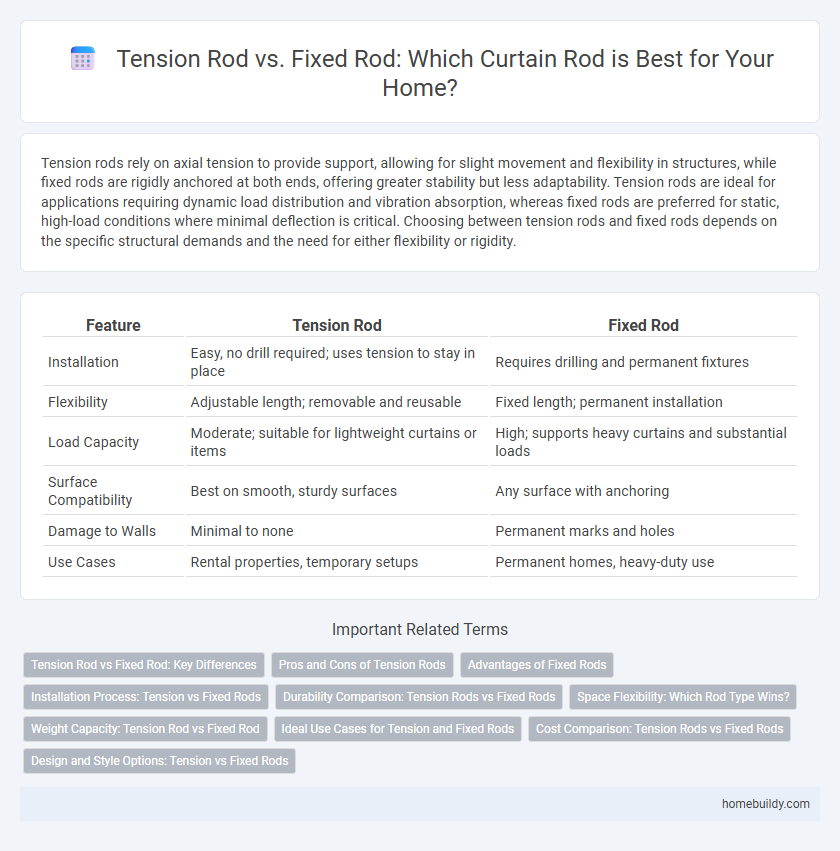Tension rods rely on axial tension to provide support, allowing for slight movement and flexibility in structures, while fixed rods are rigidly anchored at both ends, offering greater stability but less adaptability. Tension rods are ideal for applications requiring dynamic load distribution and vibration absorption, whereas fixed rods are preferred for static, high-load conditions where minimal deflection is critical. Choosing between tension rods and fixed rods depends on the specific structural demands and the need for either flexibility or rigidity.
Table of Comparison
| Feature | Tension Rod | Fixed Rod |
|---|---|---|
| Installation | Easy, no drill required; uses tension to stay in place | Requires drilling and permanent fixtures |
| Flexibility | Adjustable length; removable and reusable | Fixed length; permanent installation |
| Load Capacity | Moderate; suitable for lightweight curtains or items | High; supports heavy curtains and substantial loads |
| Surface Compatibility | Best on smooth, sturdy surfaces | Any surface with anchoring |
| Damage to Walls | Minimal to none | Permanent marks and holes |
| Use Cases | Rental properties, temporary setups | Permanent homes, heavy-duty use |
Tension Rod vs Fixed Rod: Key Differences
Tension rods use adjustable springs to hold curtains in place without drilling, making them ideal for lightweight fabrics and temporary setups. Fixed rods require wall mounts and screws, providing sturdier support suitable for heavy drapes and long-term installations. The primary difference lies in installation method and load capacity, with tension rods offering flexibility and fixed rods ensuring durability.
Pros and Cons of Tension Rods
Tension rods provide flexible installation without the need for drilling, making them ideal for renters and temporary setups while offering easy adjustability to fit various window widths. However, their reliance on tension can sometimes lead to slippage or insufficient stability under heavy loads compared to fixed rods, which are permanently mounted and generally more robust. The lightweight design and portability of tension rods are advantageous, but they may lack the durability and maximum weight support of fixed rods.
Advantages of Fixed Rods
Fixed rods provide superior stability and load-bearing capacity compared to tension rods, making them ideal for applications requiring rigid support. Their non-adjustable design minimizes movement and vibrations, enhancing structural integrity in construction and machinery setups. Fixed rods also offer easier installation and maintenance due to their straightforward, robust design.
Installation Process: Tension vs Fixed Rods
Tension rods install quickly by adjusting their length to fit securely between two surfaces without drilling, making them ideal for temporary or damage-free setups. Fixed rods require precise measurement and drilling for mounting brackets, ensuring a more permanent and stable installation. The tension rod's ease of installation suits lightweight applications, while fixed rods offer superior durability for heavy-duty use.
Durability Comparison: Tension Rods vs Fixed Rods
Tension rods offer superior flexibility and adaptability due to their adjustable nature, which prevents undue stress on mounting surfaces and extends overall durability. Fixed rods, while often sturdier because of their rigid structure, are more susceptible to damage from impact or shifting loads as they cannot absorb movement or accommodate changes. In terms of longevity, tension rods typically outperform fixed rods in environments subject to frequent adjustments or variable loads.
Space Flexibility: Which Rod Type Wins?
Tension rods provide superior space flexibility by allowing easy adjustments in length without the need for drilling or permanent fixtures, making them ideal for temporary or adaptable installations. Fixed rods, however, offer rigid stability but lack adaptability, as they require precise measurements and wall mounting, limiting repositioning options. In environments where space optimization and quick modification are essential, tension rods clearly outperform fixed rods in flexibility.
Weight Capacity: Tension Rod vs Fixed Rod
Tension rods rely on spring tension to hold weight, typically supporting light to moderate loads up to 20-30 pounds, making them ideal for curtains or lightweight objects. Fixed rods, secured with brackets or anchors, offer significantly higher weight capacity, often supporting 50 pounds or more, suitable for heavy drapes or even shelving. The fixed rod's robust installation ensures better stability and durability under heavy loads compared to the adjustable yet limited tension rod.
Ideal Use Cases for Tension and Fixed Rods
Tension rods are ideal for adjustable applications such as curtain hanging, temporary partitions, or shelving where ease of installation and removal is essential. Fixed rods are better suited for permanent fixtures like structural supports or closet rods, offering enhanced stability and load-bearing capability. Understanding these use cases ensures optimal functionality and durability in both residential and commercial settings.
Cost Comparison: Tension Rods vs Fixed Rods
Tension rods generally offer a cost-effective alternative to fixed rods due to their adjustable nature, reducing installation time and labor expenses. Fixed rods often incur higher upfront costs because of their permanent mounting hardware and more complex installation process. Overall, tension rods provide budget-friendly flexibility without sacrificing durability in many applications.
Design and Style Options: Tension vs Fixed Rods
Tension rods offer versatile design and style options due to their adjustable length and minimal hardware, allowing for easy installation without drilling. Fixed rods provide a more robust and permanent solution, often available in custom sizes and finishes that complement specific interior styles. The choice between tension and fixed rods depends on balancing aesthetic preferences with installation requirements and structural stability.
Tension rod vs Fixed rod Infographic

 homebuildy.com
homebuildy.com